
Evergreen Trees: Your Ultimate Guide to Year-Round Greenery
Published: 24/09/2024 | Updated: 24/09/2024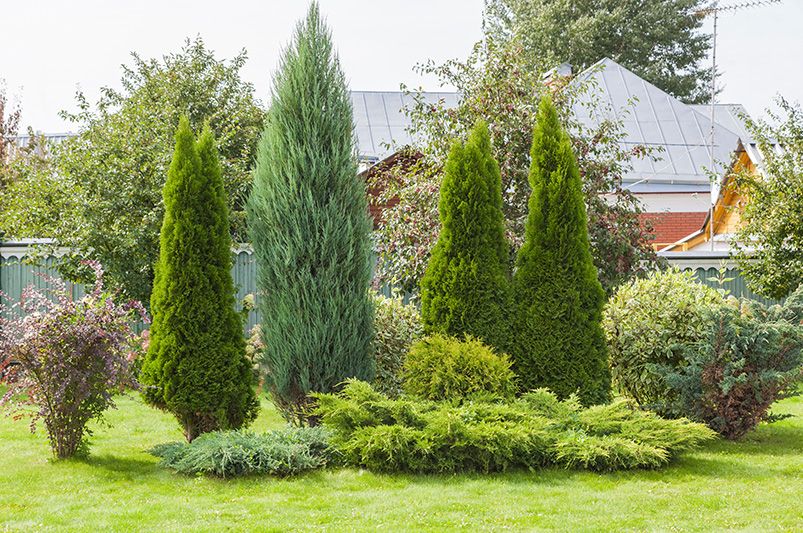
Key Highlights
- Evergreen trees offer year-round greenery, adding life and color to your landscape even during the colder months.
- These trees come in a wide array of shapes, sizes, and colors, making them incredibly versatile for various landscaping goals.
- From majestic giants like the White Pine to compact shrubs like the Japanese Holly, there's an evergreen for every garden space.
- Many evergreens are surprisingly low maintenance, requiring minimal pruning and care once they're established.
- Whether you're looking for privacy, windbreaks, or simply a stunning focal point, evergreen trees provide a lasting solution.
Introduction
Imagine a garden that stays green all year, even in the cold winter. This can happen when you add evergreen trees. Unlike trees that lose their leaves, evergreens keep their green leaves all year long. They bring color and life to your outdoor space. Because they come in different sizes and shapes, evergreen trees are a popular choice. They help add structure, privacy, and lasting beauty to any yard.


A Comprehensive Guide to Evergreen Trees for Year-Round Greenery
This guide looks at a range of amazing evergreen trees. Each tree has its own features, which can fit different needs and likes. We will go over well-known types, helping you choose the right evergreens for your yard. Besides being lovely to look at, we will also show how easy it is to add these green trees into your garden. This way, you'll have beautiful greenery all year long.
You can find many choices, like the famous Colorado Blue Spruce with its stunning silvery-blue needles. There is also the lovely Deodar Cedar, known for its drooping branches. Check out this guide to find the right evergreen trees that will add lasting beauty and bright leaves to your home.
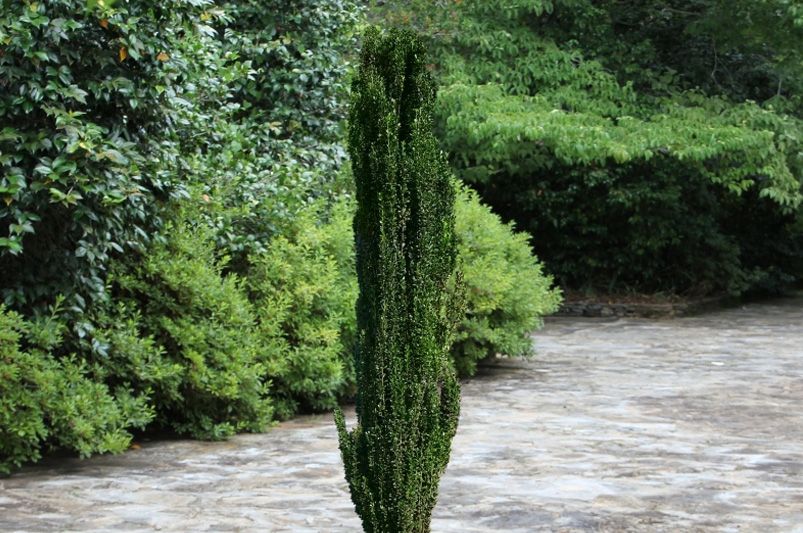
1. Sky Pencil Holly
The Sky Pencil Holly, or Ilex crenata 'Sky Pencil', is a great pick for small gardens or anyone wanting a tall, narrow plant. It has a unique columnar shape, looking like a green pole. This slender plant needs little space, making it ideal for tight areas or along paths.
This holly loves full sun but can also handle partial shade. However, it grows best and looks fuller when it gets a lot of sunlight. Its dark green leaves offer year-round coverage, making it a good option for natural privacy screens that won’t clutter small gardens.
The Sky Pencil Holly is low-maintenance and grows slowly. It doesn’t need much trimming to keep its shape. Plus, it stands up well against pests and diseases, making it popular with both new and experienced gardeners.
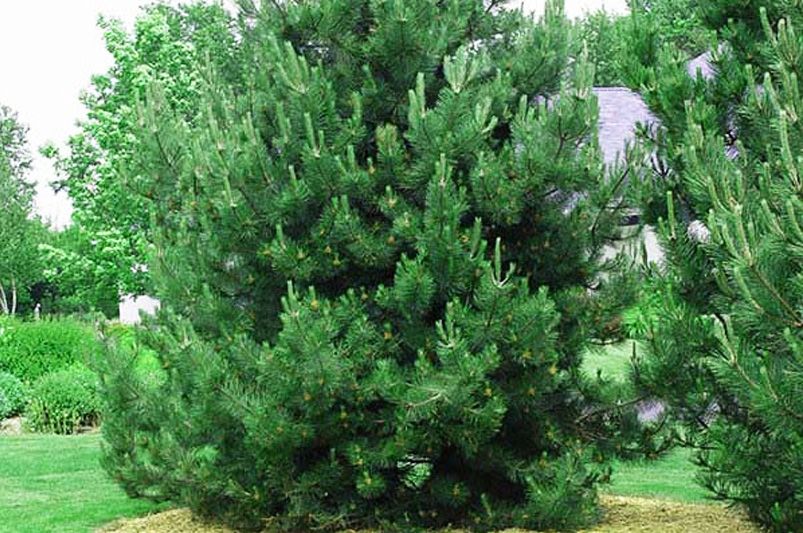
2. Austrian Pine
Austrian pine, scientifically known as Pinus nigra, is a resilient and versatile tree that serves various purposes in landscaping. Its sturdy nature makes it a favored option for creating privacy screens in outdoor spaces. With its conical shape and rapid growth rate, it thrives in sunny locations with acidic soil conditions. The striking dark green foliage adds aesthetic appeal to gardens and other outdoor settings year-round. This evergreen tree requires minimal upkeep, making it an excellent choice for individuals seeking low-maintenance yet visually pleasing additions to their garden landscapes.
In addition to its ornamental value, Austrian pine provides habitat and food for wildlife, contributing to biodiversity in the ecosystem. Its adaptability to different soil types and climates further enhances its popularity among gardeners and landscapers. Whether used as a standalone specimen tree or planted in rows for screening purposes, Austrian pine remains a reliable and attractive choice for enhancing outdoor environments.
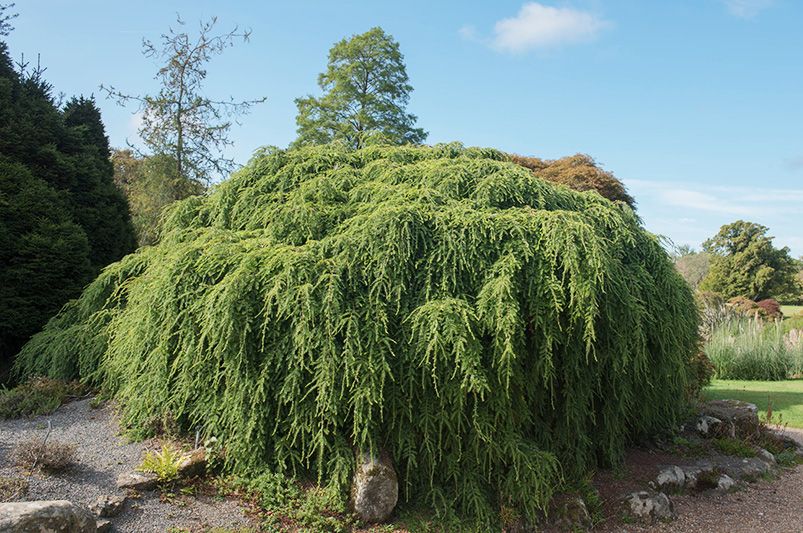
3. Canadian Hemlock
Canadian hemlock, scientifically known as Tsuga canadensis, is a visually appealing evergreen tree that is highly admired for its delicate foliage and graceful appearance. Thriving in partially shaded areas with well-draining soil, this tree is a popular choice for creating privacy screens or enhancing the aesthetic appeal of gardens. Its dense foliage and pyramid-like structure contribute to captivating views year-round, making it a sought-after ornamental tree.
One of the remarkable attributes of Canadian hemlock is its adaptability to various growing conditions, making it a versatile addition to any outdoor space. Low-maintenance and resilient, this tree adds beauty and charm effortlessly, whether planted as a standalone specimen or as part of a larger landscape design. With its enduring beauty and ease of care, Canadian hemlock stands out as a timeless and enchanting presence in garden settings.
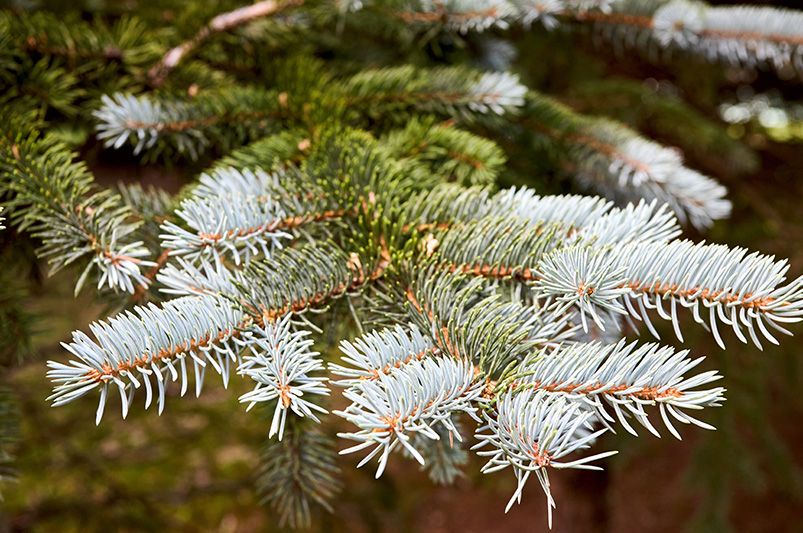
4. Colorado Spruce
The Colorado Blue Spruce, or Blue Spruce (Picea pungens), is known for its beautiful silvery-blue needles. Its eye-catching color and classic conical shape make it a favorite in many landscapes. The vibrant needles add a special touch to gardens, especially when placed alongside other evergreens for contrast.
The Colorado Blue Spruce thrives in full sun and likes well-drained soil, but it can adapt to different types of soil. It's important to keep the tree moist, especially when it is getting established. Once it is well-rooted, it can handle some drought.
Another great thing about the Colorado Blue Spruce is that it keeps its bright color all year long. This adds constant interest to the garden, even in dull winter months. Because of its symmetrical growth, it is an excellent choice for larger lawns or gardens.
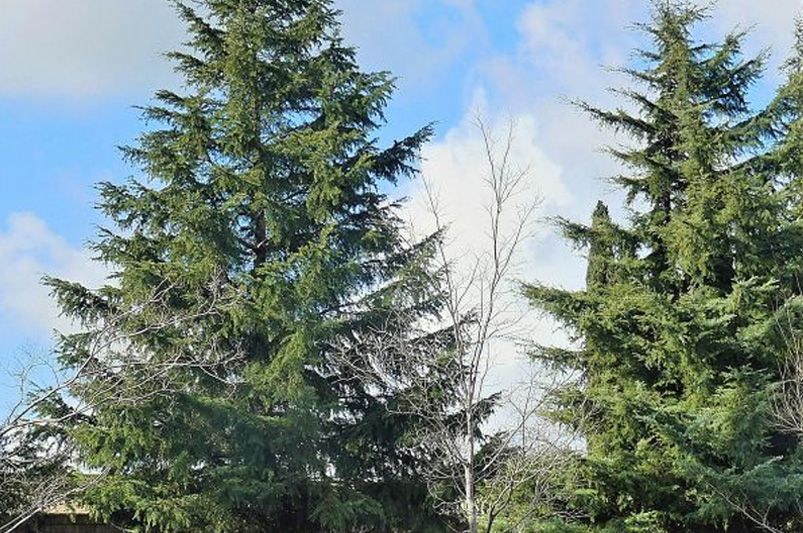
5. Deodar Cedar Tree
The Deodar Cedar (Cedrus deodara) is a lovely evergreen tree. It has unique weeping branches and grows in a pyramid shape. This tree is from the Himalayas and adds a touch of charm and exotic beauty to gardens. Its hanging branches offer a graceful and playful look.
The Deodar Cedar is good at growing in many types of soil. It likes full sun but can also grow in partial shade. Once it's settled in, this tree does not need much care. It only needs a little trimming to keep its natural look. This makes it a great choice for gardeners who want a standout tree without a lot of work.
This tree can grow very tall. It works best in bigger spaces where it can grow and extend its branches. Its elegant shape and beautiful blue-green foliage, along with its adaptability, make it a wonderful addition to parks, estates, and large gardens.
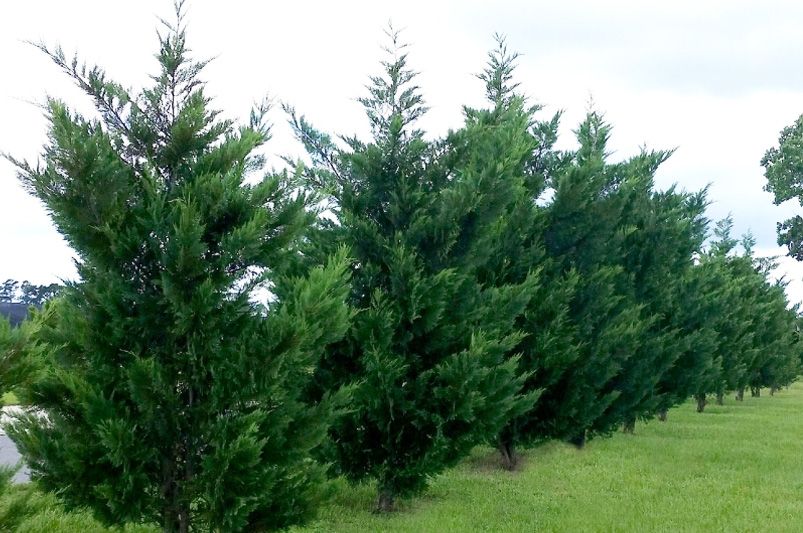
6. Cypress 'Leyland'
The Leyland Cypress is favored for its effectiveness as a privacy screen due to its rapid growth and dense foliage. This evergreen tree thrives in full sunlight, making it an ideal choice for outdoor settings. Its conical form and vibrant green leaves enhance the aesthetic appeal of any garden or landscape. Regular watering is essential for this tree, and it flourishes in acidic soil conditions.
Apart from its practical benefits, the Leyland Cypress is also a low-maintenance plant that can effortlessly elevate the beauty of your garden. Consider adding this tree to your outdoor space if you are seeking a hassle-free yet visually striking addition to your landscaping.
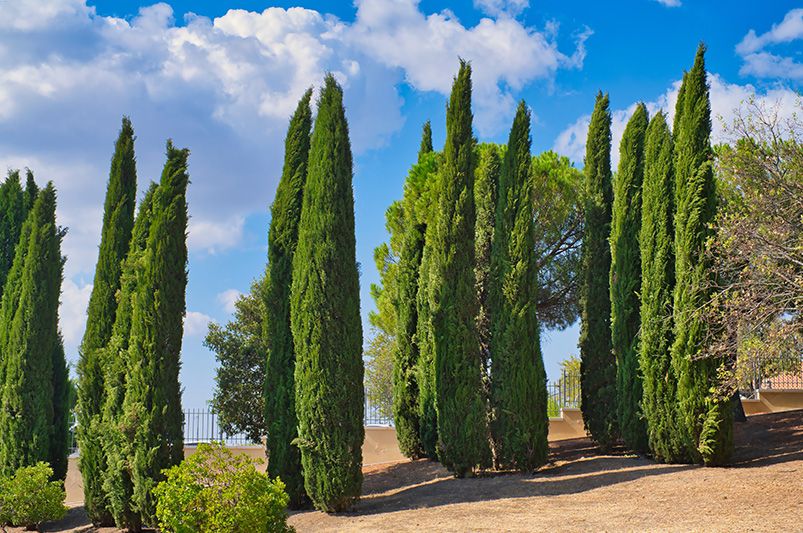
7. Blue Italian Cypress
The Blue Italian Cypress (Cupressus sempervirens) adds a unique Mediterranean style to any garden. It has a tall, narrow columnar shape and beautiful blue-green leaves. This tree comes from the eastern Mediterranean. It reminds us of lovely Tuscan landscapes. People often use it for formal touch, to line driveways, or to highlight buildings.
The Blue Italian Cypress grows naturally tall and thin. It doesn’t need much trimming to stay looking good. It grows best in full sun and well-drained soil. Once it's established, it can handle dry spells, making it a smart choice for dry areas.
Even with its beauty, the Blue Italian Cypress can suffer from root rot if the soil does not drain well. It’s important to provide good drainage and not overwater it. This helps keep the tree healthy for years.
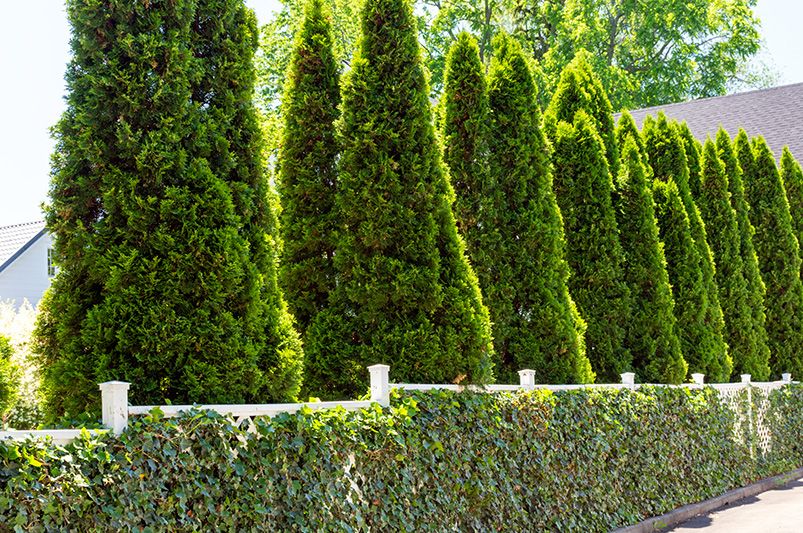
8. Arborvitae 'Emerald Green'
The Arborvitae 'Emerald Green' (Thuja occidentalis 'Emerald Green') is a very popular evergreen plant. It is great for privacy screens and hedges. People like it because of its compact, pyramidal shape and its thick, bright green foliage. This plant grows densely, making it a fantastic option for living walls. These walls not only provide privacy but also look beautiful.
The Arborvitae 'Emerald Green' can adapt well to different growing conditions. It likes full sun or partial shade. It also does best in well-drained soil. Its ability to handle different soil types and light conditions makes it a strong choice for many gardens.
This plant is low-maintenance, but it does need regular pruning. Pruning helps keep its shape and stops it from getting too dense. A plant that is too dense can be more likely to get diseases.
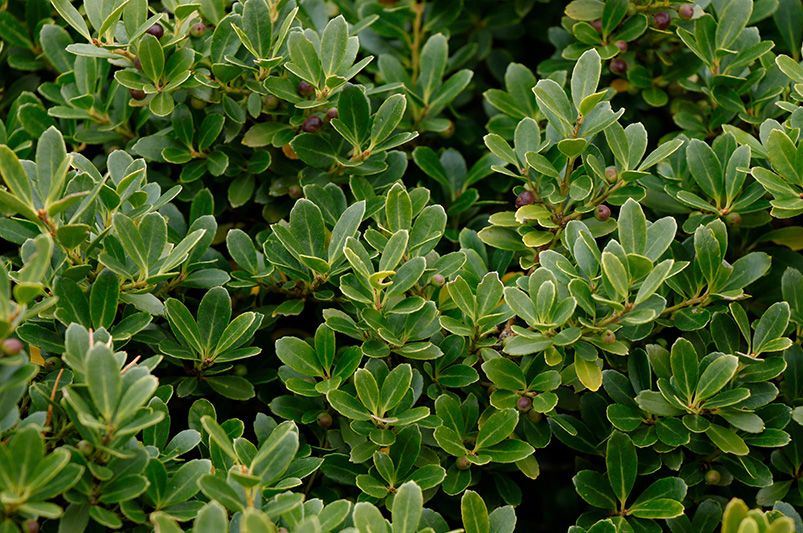
9. Japanese Holly
The Japanese Holly (Ilex crenata) is a small evergreen shrub. It has shiny leaves and grows densely. People often use it for hedges, foundation plantings, or topiary. It is a very popular choice because you can prune it into different shapes. This makes it great for formal gardens and cool geometric designs.
The Japanese Holly does well in full sun or partial shade. It likes soil that drains well. Its ability to be pruned and its tolerance to light allow for creativity in the landscape.
Additionally, the Japanese Holly has some seasonal charm. In spring, it produces small white flowers. Then, in fall and winter, it has small black berries that provide food for birds.
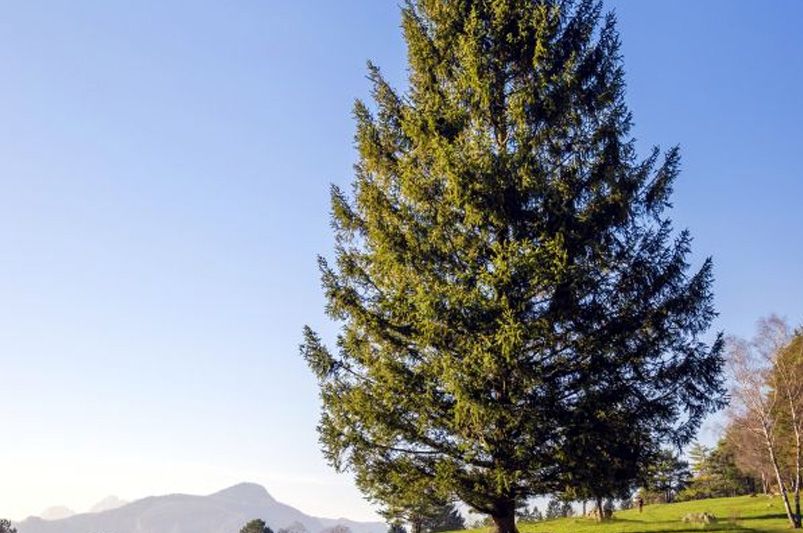
10. Norway Spruce
The Norway Spruce (Picea abies) is easy to recognize with its graceful, drooping branches and distinct pyramidal shape. It grows fast and reaches a large size quickly. This rapid growth makes it a good choice for creating privacy screens or windbreaks in your yard.
This tree likes full sun and needs well-drained soil. It can grow in many different types of soil but needs enough moisture, especially when it's dry. If not, it may face drought stress.
The Norway Spruce is usually low-maintenance. However, it may need regular pruning to keep its shape or to control its size. This is especially true in smaller spaces where there is limited room.
Caring for Your Evergreen Trees
Evergreen trees are known for being easy to care for and strong, but they still need the right care to stay healthy and colorful all year. To help your evergreens grow well, you should know their basic needs like soil, sunlight, water, and pruning.
It’s important to set up a watering plan that fits their growth rate and the weather. You should also take steps to prevent pests and diseases. By paying attention to your evergreens, you can keep them lively and healthy in your garden for many years.
Understanding Soil Needs and Sunlight Exposure
When picking a place for your evergreen tree, it is important to think about the soil type and how much sunlight it gets. Most evergreen trees grow best in well-drained soil. If your soil holds on to water, adding organic matter, like compost, can help. This makes the soil better for your tree.
Most evergreen trees like full sun. This means they need at least six hours of direct sunlight each day. However, some types, like the Canadian Hemlock, can grow in partial shade. This makes them good for areas in your yard with less sun. Knowing how much sunlight your evergreen needs is important for its growth.
You can do an easy soil test to check its pH level and nutrients. This will help you choose the right amendments or fertilizers. Doing this will fix any problems and give your evergreen tree the best chance to grow well.
Watering: How Much and How Often
Newly planted evergreen trees need regular watering, especially in their first year. This helps them grow strong roots. How much and how often you water depends on the growth rate of the tree, the size of the hole you planted it in, your local climate, and the season.
Typically, it’s best to water deeply instead of just a little bit. Deep watering helps the roots reach deeper into the soil. This makes the tree stronger against drought in the future. It’s better to water less often but more deeply than to water a lot but just on the surface.
Keep an eye on the tree for signs that it needs more water. Signs like wilting or brown needles show it may be stressed from lack of water. If you see these signs, you should water it more often. Change your watering schedule to meet the tree's needs and the conditions around it.
Pruning Tips to Maintain Shape and Health
Many evergreen trees need very little care and don't require a lot of pruning. Still, smart pruning can help keep their shape, improve their look, and stop them from getting too thick. It is also important to regularly remove dead, damaged, or sick branches to keep the tree healthy.
When shaping trees, try for a natural look instead of a perfectly neat one. This usually means trimming branches that are in the wrong spot or getting in the way of other plants. The best time to prune most evergreen trees is in late winter or early spring.
Avoid heavy pruning in late summer or fall. This can lead to new growth that might not get strong enough before winter comes.
Protecting from Pests and Diseases
Evergreen trees usually resist pests well. However, some pests and diseases can still be a problem. Check your trees often for signs like discoloration, webbing, or strange growths. This will help you catch issues early and stop bigger problems.
To manage diseases, you should follow some good practices. Keep enough space between trees for good air flow. Avoid watering from above, and throw away any infected plant parts properly. These steps help keep your trees healthy.
If you find a pest or disease issue, it’s a good idea to reach out to a certified arborist or your local Cooperative Extension Service. They can help identify the problem and suggest treatment options.
Landscaping with Evergreens: Ideas and Inspiration
Evergreen trees are more than just plants. They can help make your outdoor space beautiful and useful. You can use their dense foliage to create natural privacy screens, mark your property lines, or lower noise from busy streets.
These trees can also be part of your garden design. They can serve as eye-catching focal points, enhance lovely views, or provide a green background for bright seasonal flowers. With a bit of planning and imagination, you can change your outdoor space using evergreen trees.
Creating Natural Privacy Screens
One popular way to use evergreen trees in landscaping is to make natural privacy screens. Their thick, green leaves offer great visual barriers. They help create a private area, keeping unwanted views away and allowing for cozy garden spaces.
When planting for privacy, think about the size and how fast the evergreen trees grow. Fast-growing types, like Leyland cypress, can form a screen quickly. However, they might need cutting back more often to keep their size in check.
Spacing is also very important. If you want a thick privacy screen, plant the trees closer together. Make sure to consider how wide they will get when they are fully grown. This careful planting makes a green wall that can fully shield your outdoor space from people looking in.
Incorporating Evergreens into Garden Design
Evergreen trees are useful and make gardens look better. They add structure, color, and texture. Their green leaves all year create a steady background for seasonal plants and flowers. This makes a beautiful and lively garden.
You might want to plant a tall evergreen, like the Colorado Blue Spruce, as a main focus in your garden. Its unique color and shape will catch your eye. Or, you can group smaller evergreens like Japanese Holly. This can help create borders, mark pathways, or add interest near buildings.
It’s important to add evergreens carefully to your garden design. Think about how big they will get, their shape, and color compared to other plants and features.
Conclusion
Evergreen trees are a great choice for keeping your garden green all year long. Trees like the Sky Pencil Holly and the Norway Spruce are not only nice to look at but also useful. When you learn how to care for them and use them in your yard, they can make your outdoor space even more beautiful. You can use evergreens to create natural privacy screens or add them to your garden design. There are many different types to choose from, so you can find the right one for your garden. Enjoy the lasting beauty of these amazing trees. Don't forget to share your love for evergreen trees on social media to encourage others with their landscaping projects.
Frequently Asked Questions
How do I choose the right evergreen tree for my garden?
Think about your outdoor space, the type of soil you have, how fast the tree grows, and how much sunlight it gets. Also, consider how the tree fits in with your garden design. Talking to someone at a local nursery can help you choose the right evergreen tree for your needs and your climate.
Need Assistance for a Complete Landscape Makeover?
Shrubhub’s landscape design packages can significantly transform the lives of homeowners by delivering customized, professional landscaping plans tailored to their unique space and personal style. With the ease of online collaboration, you are guided step-by-step through a design process that fundamentally reshapes your outdoor environment. The result is an aesthetically pleasing and functional outdoor living area that maximizes the potential of your property.
Sign up now for free and get a whopping 70% discount on your landscape design!


